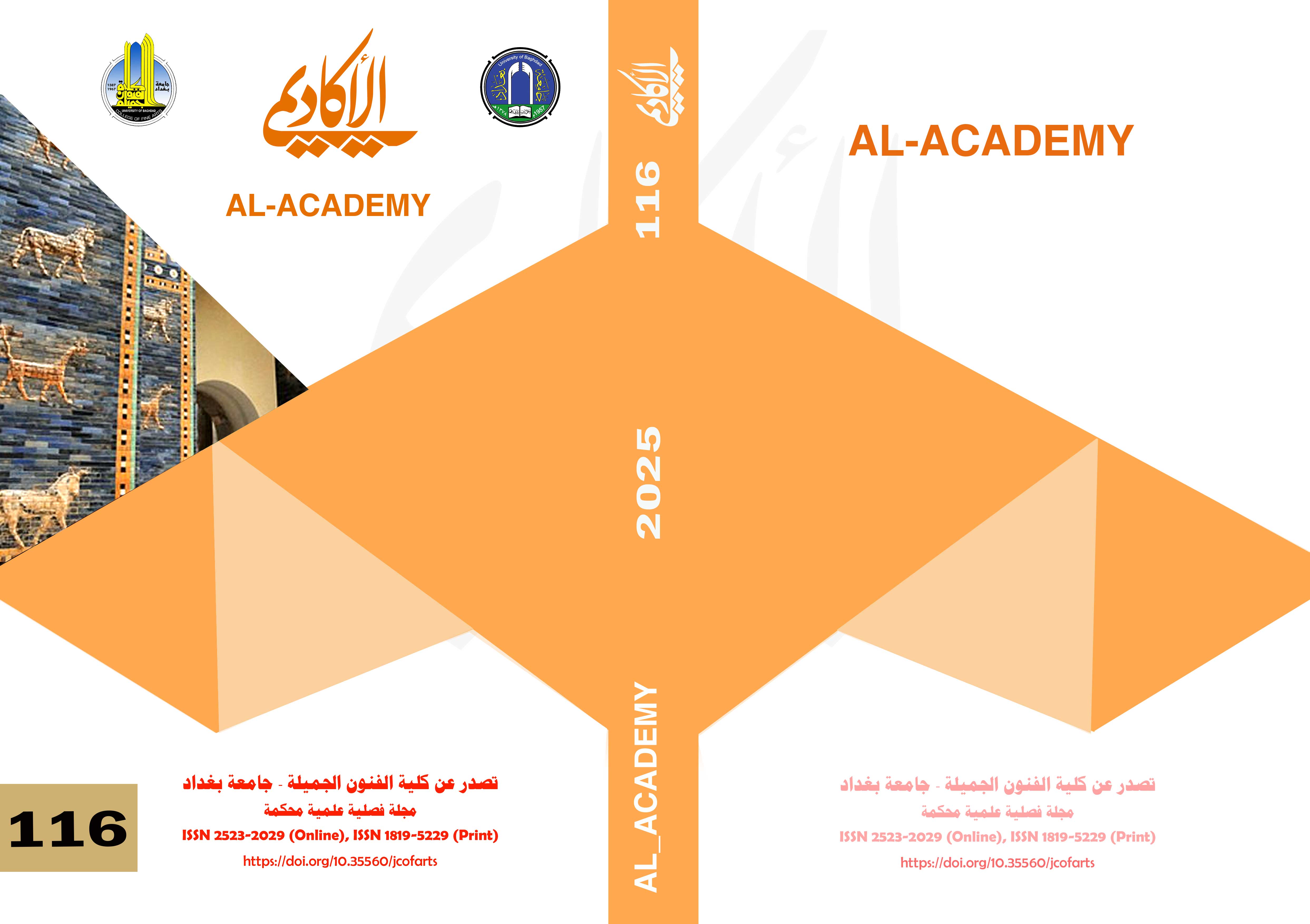The aesthetic formation of the duality of voice and silence in the performance of the Iraqi theatrical actor (Amal play as a model)
DOI:
https://doi.org/10.35560/jcofarts1596Keywords:
formation, beauty, sound, silenceAbstract
This study aims to deeply understand the (aesthetic formation) of the duality (sound and silence) in the theatrical actor’s performance by analyzing all the technical, aesthetic and psychological factors associated with (sound and silence) to reach a clear understanding of their impact on the actor’s performance and his success in communicating effectively with the audience. Therefore, New techniques will be highlighted to enhance the actor’s abilities in expressing thoughts and feelings through (voice and silence) in conveying the theatrical message, in addition to the importance of physical factors with physical language in feeding the actor’s performance of the character. This research will contribute to deepening our understanding of the actor’s tools that enhance the development of his abilities. Performance on stage .
This is what was explained in the research chapters represented by the first chapter (methodological framework) and the second chapter, which consisted of the first topic (the aesthetic concept of duality of form and morphology) and the second topic (the effectiveness of sound and silence in acting performance), leading to the third chapter (research procedures), which included an analysis of the play (Hope) and Chapter Four (Results and Conclusions, including):
1- Both (Sound and Silence) clearly depict the psychological state of the two characters (Amal and Basem) through performative transformations on the physical and vocal levels.
2- The audio system intended to add a state of instability and stability to the physical system through the emotions of the two characters throughout the show.
Keywords: form, beauty, sound, silence.
References
- Abbas Muhammad Reda, Mahdi Abdul Amir Muftin, 2015: The Term of Silence, (University of Babylon - Journal of the College of Basic Education for Educational and Human Sciences, No. 4.
- Al-Ragheb Al-Isfahani, 1972: A Dictionary of the Words of the Qur’an, Jamal’s article, edited by Nadim Maraachli, Dar Al-Katib Al-Arabi.
- Adel Mustafa , 2018: The significance of form, a study in formal aesthetics and a reading of the book on art, (United Kingdom: Hindawi Foundation).
- Aqeel Mahdi Youssef, 2011: The Aesthetic Idea in Art, 1st edition, (Iraq - Erbil: Aras Printing and Publishing House.
- Al-Qabas Dinwar, 2018: The Art of Silence, by Qasim Miqdad, 1st edition, (Damascus: Nineveh House for Studies, Publishing and Distribution.
- David LeBroughton , 2019: Silence is the Language of Meaning and Existence, by Farid Al-Zahi, 1st edition, (Morocco: Cultural Center for Books).
- Hamada Ibrahim, 2005: Dramatic Language, Unspoken Elements and Spoken Elements, 1st edition, (Cairo: Supreme Council of Culture).
- Ibrahim Anis, 1999: Linguistic Voices, (Cairo: Anglo Egyptian Library.
- Ibrahim Mustafa and others, 1989: Al-Mu’jam Al-Wasit, 1st edition, (Cairo: Dar Al-Da’wa for Printing, Publishing and Distribution.
- Joseph Boggs, 1995: The Art of Watching Films, by Fouad Abdullah, (Cairo: Egyptian General Book Authority).
- Karim Zaki Hossam El-Din, 1985: Heritage Principles in Linguistics, 2nd edition, (Cairo, Anglo-Egyptian Library.
- Muhammad Ali Al-Farouqi , 1963: Revealing the Conventions of Arts, edited by Lotfi Abdel Badie, Jamal’s article, Cairo.
- Nadim Mualla, 2004: The Language of Presentation, 1st edition, (Iraq: Al-Mada Foundation for Media, Culture and Arts.
- Reham Ihab Khalil, Adel Adly Ibrahim, 2020: Methodology of morphological construction of the Pharaohs’ goods, (Cairo, Faculty of Applied Arts, Helwan University, Journal of Design Sciences and Applied Arts.
- Safra Naji, 2011: Silence in contemporary absurd theatrical literature as a model, 1st edition, (Syria: Dar Al-Yanabi’ for Printing, Publishing and Distribution.
- Shaker Abdel Hamid, 2001: Aesthetic preference in the psychology of artistic taste, World of Knowledge Series, No. 267, (Kuwait: National Council for Culture, Arts and Letters).
- Zaki Naguib Mahmoud, 1937: Plato’s Dialogues - Phaedo Dialogue, Al-Jannah Publishing House.














